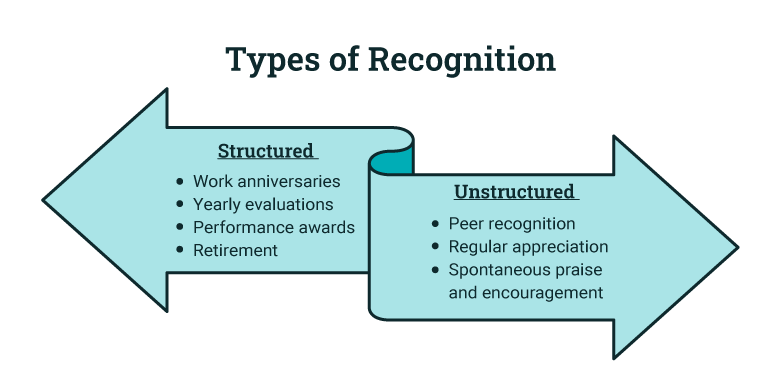There are about 2,400 Google searches per month for ’employee recognition ideas.’ and 1900 for ‘employee recognition programs.’
It’s clear that managers and HR professionals alike are constantly looking for advice on how to motivate employees and make them feel more appreciated.
It's likely; however, many of these companies already have strategies to reward and recognize employees. For example, yearly raises or performance reviews.
Despite this, employees continue to feel unrecognized...
Why does this happen?
Different types of recognition
Think about the difference between these scenarios:
- Receiving private recognition from your manager for a specific accomplishment.
- Received a quick “good job” from a senior leader.
- Receiving a trophy publicly in front of your peers for your yearly performance.
Not all recognition is created equal. As you can see from the examples above, each situation would feel good to an employee for different reasons.
Ultimately, there are two main types of recognition: structured and unstructured.
To that end, a mix of both types of recognition is required to meet different employee needs and achieve a culture of appreciation.

The ideal blend of recognition
There are many reasons to give employees recognition. So if your employees claim they are feeling underappreciated or “not recognized enough,” it's probably because your recognition systems or programs are focused too much on one type of recognition.
For example, maybe you have years of service program in place and yearly evaluations, so employees are only getting recognized once or twice a year. Managers are not taking the time to give personalized recognition for smaller accomplishments in between those bigger milestones.
So what's the solution?
Make sure to pepper both structured and unstructured forms of recognition throughout the year.
This article will elucidate all the most important forms of recognition and the benefits and drawbacks of each. This way, you will see exactly why each type of recognition is essential to employee happiness and motivation.

5 forms of recognition that are essential to employee motivation
Raises or performance bonuses
People want to feel their contributions and efforts are rewarded. External motivators can be extremely powerful. Motivation can quickly fall if businesses don't reward effort and contributions accordingly.
Traditionally, offering raises or performance bonuses is the most common way to recognize employees' work and effort. However, there are benefits and drawbacks.
Benefits: One of the main benefits of raises or performance bonuses is that it's a tangible reward for their work. In other words, a monetary reward is a reflection of the effort and value an employee adds to the company. This makes the employee feel a sense of control over their earnings, which directly impacts their motivation for the job. This is a great tactic for promoting long-term motivation.
Drawbacks: The drawback of monetary reward is that it doesn’t happen very often. Raises typically only happen once a year, and often they are given at a minimum and do not always reflect the actual value of the employee's contributions.
This is why ultimately monetary rewards are important, yet not enough to truly make employees feel valued and appreciated.
Promotions
When employees are promoted into a new position or given a new set of challenges and responsibilities, it can feel extremely validating. This can fill employees with a sense of pride and accomplishment that is critical for feeling meaning and purpose at work.
As such, promotions or title changes can be a very important way organization can recognize employees for their hard work.
Benefits: The main benefit of using promotions as a method for showing appreciation is that it makes employees feel a deep sense of pride and accomplishment. As such, it can bring a renewed sense of vitality and energy to a person and give them a boost of confidence and motivation.
Drawbacks: The main drawback is that promotions are infrequent, usually even more than raises or bonuses. Typically employees get promoted at 2 to 4-year intervals. As such, in most organizations, there are not enough promotions and new opportunities to go around. So only a select few employees will be offered promotions each year.
Performance awards
Certain types of positions and industries are ideal for these types of awards. Typically sales representatives are offered performance awards for exceeding their quotas. But performance awards programs can be organized for any employees that work around set quotas and goals.
Performance awards are generally offered publicly, and therefore can be very validating and create a positive feeling for the recipient. In addition, the reward is directly related to the performance of the employee, so it can feel very validating to have your efforts recognized by the whole company.
Benefits: In that sense, the main benefit of performance awards is the fact that they are directly tied to performance and bring attention directly to an employee's effort and contributions.
Drawbacks: The main drawback of these recognition systems is that they are infrequent and not inclusive. Meaning, that not everyone will have a chance to be recognized. Only the highest performers receive awards, yet someone who contributes in smaller, less visible ways will not get recognized.
Performance evaluations
Formal evaluations are commonly done either on a quarterly, bi-yearly, or yearly basis. And traditionally speaking, formal evaluations were one of the few times of year employees receive recognition for their work.
Managers can use performance evaluations as an opportunity to give their employees thoughtful and personalized feedback.
However, the reality is different for many businesses. Unclear expectations, overwork, and poor performance management systems result in performance evaluations that are generic and lackluster. In short, performance evaluations are dreaded by many managers and recognition is rushed and incomplete.
That said, not all companies operate in this way, so if we assume managers take the time to deliver well-rounded performance evaluations, it can be a beneficial form of recognition.
Benefits: Receiving recognition during a performance evaluation allows the employee to be recognized personally by their manager. Bringing out the employee's biggest accomplishment for the quarter or year will leave the employee feeling proud and valued.
Drawbacks: The drawback of performance evaluations is that they are infrequent. In addition, praise is often limited to the highest levels of accomplishments. Smaller forms of taking initiative might not be praised as much. Due to the standardization of performance evaluation systems, recognition often seems impersonal, especially if the manager does not take the process seriously. This can happen in companies that don't have a mature performance evaluation system in place or have other systematic problems preventing managers from evaluating employees effectively.
Peer recognition
In the workplace, it’s most common to see managers giving recognition to employees. This type of traditional “top-down” recognition is important, but it can also have some downsides.
Namely, putting all the pressure to give recognition on managers can make managers feel like recognition is another thing on their to-do list. And it can also make managers feel unappreciated themselves.
Benefits: That’s why peer recognition is so important. The main benefit of peer recognition is that It helps take some of the pressure off of managers. But most importantly, it also helps keep recognition continuous by filling in the gaps between more formal forms of recognition.
Drawbacks: Peer recognition isn't without its drawbacks either, the main one being that it can be difficult to get employees into the habit of giving regular recognition to each other. Then, you need to set up a framework or program to allow employees to evaluate each other or post recognition on apps such as Applauz.
Ongoing verbal recognition
When employees say they don’t feel appreciated or valued, a great deal of the time, it's because they are not receiving this type of unprompted, genuine recognition from their leaders.
Dr. Paul White, an expert on recognition in the workplace, explains in his book The Vibrant Workplace why this happens.
Formal and organizationally driven recognition programs (like years of service programs) can be motivating, but they are rarely personalized. Employees are given a generic trophy and given basic praise for high levels achievements, sometimes there’s no note of appreciation at all!
Because not all of their efforts are highlighted, employees can feel cynical as a result.
In other words, what Dr. White is trying to explain is that for recognition to have maximum impact on morale and engagement, it should be specific and come from a place of authenticity. Like when a manager shares words of recognition, it's not because they’re “forced” to by a program, but because they genuinely want to.
Benefits: That is the main benefit of ongoing verbal recognition, it’s the most emotionally impactful and, therefore, effective at stimulating employee motivation and happiness.
Drawback: The main drawback is similar to peer recognition in that managers can often push back on giving this type of recognition, claiming “it will cause favouritism,” or “I simply don’t have time.” In short, it can be difficult for organizations to ensure on a systematic level that employees are receiving this type of recognition regularly.
A recognition program such as Applauz would provide organizations with a dedicated place for giving recognition, which can make it easier for managers to get started on the right track toward giving regular recognition.
Quality time
Typically we associate recognition with verbal appreciation. This verbal appreciation can sometimes be accompanied by trophies, plaques, or monetary rewards.
In the book, 5 languages of Appreciation in the Workplace, author and expert on workplace recognition Dr. Paul White, explains why many recognition programs fall short. It's because employees are not receiving personalized recognition in their language of appreciation.
His research explains that there are 5 languages of appreciation, and quality time is a critical one for many employees.
Quality time can mean carving out dedicated time to talk to your employee about their professional goals and aspirations. It can also mean making time to give them a specialized coaching session about a skill they have been wanting to learn.
Benefits: The main benefit of this type of recognition is that it is highly personalized. It also works to forge a strong bond between manager and employee. This trust can lead to better work relationships and happier employees, of course.
Drawbacks: The downside of quality time is the time! Most managers are very busy. And dedicating time to sitting down with employees for these types of meetings can be difficult.
Final Note: Speak to Your Employees
On an important and final note, if you or company managers are ever unsure of whether your business is doing a good job at recognition, we highly recommend that you speak directly to employees.
A lack of recognition remains one of the most common reasons why employees leave an organization. And most employees aren't going to raise this topic directly with their managers.
If your employees do not feel valued, disengagement can quickly set in, and you could lose a valuable employee before you even realize it.
Fortunately, this can easily be avoided with simple communication.
For example, managers can make a point to let employees know they want to make sure they are feeling appreciated and valued, and ask some of the following questions:
- Do you feel recognized and appreciated for the work you do?
- How can I better show recognition and appreciation for your work?
- What type of recognition do you prefer to receive?
Some managers may find it odd to discuss this topic with employees. Yet sometimes, an honest and open conversation is necessary. Keeping track of expectations in terms of recognition (and if your business meeting them) is vital in ensuring that no employee is left feeling frustrated or resentful.
About the author
 Michelle Cadieux
Michelle Cadieux
Michelle is a content writer for Applauz. She holds a Bachelor's degree in Psychology from Concordia University, and she has been writing about work and employee happiness for over five years.



